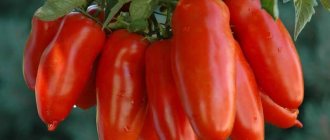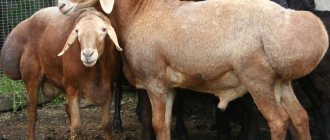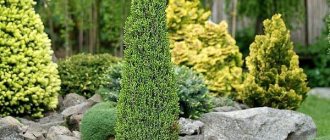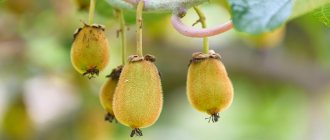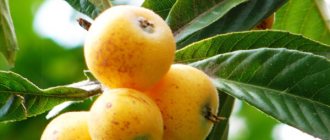Passion fruit varieties for growing on a windowsill
Breeders have developed 3 hybrids that can be grown at home
| Variety | Appearance and taste characteristics | Features of care |
| Purple passion fruit or Edulis | The fruits are purple in color, 6-8 cm in diameter - this is slightly smaller than the yellow fruits. They taste sweeter and are used to make drinks and desserts. | The least demanding variety is in demand for this reason. |
| Blue | The flowers of this passion fruit variety are blue, and the fruits are yellow or orange. In shape they resemble chicken eggs, the average diameter is 8 cm. The taste qualities allow the variety to be used as a complement to charlotte apples. | Unpretentious to temperature conditions. |
| Banana | The fruits are juicy and fleshy. They contain a large number of organic compounds and acids. | Actively bears fruit in the first years of life. Resistant to low temperatures (withstands frosts down to -2 degrees). |
For myself, I chose the Edulis and Blue varieties. They are easy to care for, and the taste characteristics of the fruit allow me to prepare all types of desserts from them, from charlotte to sweet drinks. By the way, in addition to passion fruit, you can try growing pineapples at home. Arrange an exotic vegetable garden on your windowsill!
My favorite variety is Blue Passion Fruit
Rules for caring for passionflower at home
Liana loves bright direct color, but at noon on a south window it requires shading. At the same time, the pot should always have moist soil, the leaves should be irrigated with a spray bottle, and nearby there should be an aquarium-shaped lake or a damp tray with moss and pebbles. In the shade, you can't wait for flowering. A constant supply of fresh air to passionflower must be ensured. She will wither away in a stuffy room. But the tropicana cannot stand a draft either.
When buying seeds, you need to find out where the homeland of this passionflower is. If the plant is from humid subtropics, they have special requirements for moist air. Alpine varieties do not tolerate heat, tropical varieties require sun and heat.
After winter insufficient lighting, the plant is gradually introduced into summer. Later, it can be kept outside, on an open balcony. However, in winter, additional lighting with cold glow lamps is required for up to 12 hours.
During the dormant period, the comfortable temperature for passionflower will be 14-18 degrees. In summer it is kept at 20-260 C.
During the period of growth of vines and shoots, the plant is fed weekly with organomineral fertilizers. The liana grows quickly, clings to the provided supports and can be twisted, creating the desired shapes, until the shoot becomes woody. The whip can reach 10 meters. Therefore, systematic pruning will help keep the passion fruit within the given dimensions. However, you need to cut it 10 cm from the trunk, otherwise the plant will die. Pruning is carried out gradually, 1-2 branches at a time. The vine itself can be shortened by ¾ of the length. After the procedure, the leaves themselves will turn towards the sun.
During pruning, the roots that feed the branch die. They remain in the pot, providing food for the bacteria. So you shouldn’t overuse pruning. Flowers develop only on young growth. Later, a fetus may form. But this will happen with artificial pollination if there are at least two plants of the same species, since cross-pollination.
Passion flowers themselves fight their enemies. So, they attract ants with sweet secretions. Ants destroy wasps that eat pollen from a flower. To prevent the helicoid butterfly from laying eggs, dummies are formed on the leaves, replicating eggs. The butterfly flies away, since those who came out earlier will eat the leaf, and starvation awaits the new caterpillars.
Fungal and infectious diseases on the vine are difficult to treat; more often than not, passionflower dies at home. Among the pests it fears are red spider mites, aphids, mealybugs, and whiteflies.
How to grow passion fruit at home
Let's start with choosing a container, preparing the soil and seeds for sowing.
Correct container
The seeds can be sown first in a container, and then the sprouts can be planted in separate pots. I prefer to immediately plant the seeds in plastic pots (they are cheaper and lighter than ceramic ones). You need to make holes in the bottom of the container and add a drainage layer
2-3 cm thick made of expanded clay, pebbles or broken bricks or ceramics. This is necessary to prevent rotting of the root system and the plant as a whole.
Soil selection and preparation
I prepare the soil myself. To do this, I mix in equal parts:
- chalk,
- peat,
- mineral fertilizers,
- clay,
- land.
Before planting, I moisten this mixture well. If you are too lazy or not able to create the necessary composition, you can use soil from the store. For example, I often use the universal Zeoflora Moisture-Saving Primer. It consists of particles of the zeolite mineral with a diameter of 3 to 10 mm.
Preparing seeds or pits
Most often I use passion fruit seeds as planting material. To prepare them I do the following:
- Immediately after cutting the fruit, I wash the seeds and dry them with a towel.
- I remove the top layer from the bone with sandpaper. This is required to speed up germination.
- At a temperature of 20-25 degrees, I soak the planting material in milk for 4-5 hours.
- Next, I proceed directly to planting.
I usually treat the seeds with Kornevin solution. To prepare it, I take 1000 mg of the substance per 1 liter of water. I soak the seeds for 18-20 hours before planting.
Author's note
Natalia Papanova
Blog author
Prepare the solution in a container that will not be used for food in the future. Use rubber gloves during the process.
I plant seeds and seeds according to the following algorithm:
- After watering the soil in advance, I make a small hole of 1 cm in it.
- I put the treated seed there, sprinkle it and water it again.
- I place a third of a plastic bottle with a neck on top. This is necessary to create a microclimate.
- I leave the container in a room with a temperature of 21-23 degrees. There should be plenty of light in the room, but do not allow direct sunlight to hit the container.
- Once every 2-3 days I remove the bottle for a few minutes to air it out.
Usually sprouts appear after 2-3 weeks, sometimes after a month.
Do you have a desire to try some other exotic plant? Find out if you can grow lychees from seed at home.
How to get passion fruit seeds
What kind of plant is passion fruit?
Edible passionflower is a representative of evergreen vines, the stems of which intensively gain growth. An adult plant reaches a length of up to 45 meters. The original structure of the openwork leaves and the color of the inflorescences provide high decorative properties of passion fruit. Thanks to the rapid growth of greenery and a long flowering period, the crop has gained popularity among gardeners. It is used as decoration for gazebos, pergolas, recreation areas, garden arches and fences.
During the flowering of passionflower, leaves, buds, and inflorescences are harvested for further drying. Such preparations are used for preparing teas, infusions and other traditional medicine. Their composition is enriched with healing microelements that have antifungal, antispasmodic and antibacterial effects.
Passionflower is used in the manufacture of pharmacological preparations that have a sedative effect. Dry preparations are included in dietary supplements intended for the treatment of drug and alcohol addiction.
Where and how it grows in natural conditions
Passion fruit is native to tropical forests that experience a stable, hot, humid climate. The culture grows everywhere in South America. The largest part of the varieties is concentrated in the southern regions of Brazil, Paraguay, and northern Argentina.
The plant can also be found in some regions of Australia and Asia. More than 500 representatives of passionflower form edible fruits. The berries have valuable nutritional properties and are positioned as a dietary product.
Reference! The calorie content of passion fruit is 68 kcal.
The above-ground part of the plant, as well as the fruits, have medicinal properties. The preparations are used in traditional and alternative medicine. Stems and leaves contain a whole storehouse of useful chemical compounds:
- alkaloids;
- glycosides;
- carotenoids;
- flavonoids;
- quinones;
- saponins and other vitamins, minerals.
How to properly care for passion fruit
After the sprouts appear, they need to be planted in pots and provided with proper care. This will make it possible not only to grow a passion fruit flower, but also to harvest it.
The fruits of the plant have an unusual taste and aroma
Proper watering
After the sprouts appear, I slightly reduce watering. The plant does not like excessively high humidity and may rot. It is necessary to water when the soil surface is dry.
Lighting, humidity and air temperature
The plant loves light, but it is better to hide the seedlings from direct rays.
Adult plants tolerate this normally. Comfortable temperature for passion fruit is 20-25 degrees. In winter, do not allow it to drop below 12 degrees. The plant loves moist air, so in hot summer or when the heating is at maximum in winter, I spray the leaves with water every 1-2 days.
Have you tried growing passion fruit at home?
Not really
Transfer
If the size of the pot and the plant do not match, it will have to be replanted. This usually occurs in the third or fourth year of life. I replant in late spring or early summer. During the process, the main thing is to ensure that the lump of earth around the roots does not collapse.
Reproduction
Reproduction can be carried out by seeds (as I already described above) or by cuttings. I like the last method better. To do this you will need:
- Find a shoot with at least 2-3 leaves.
- Root at a temperature of 21-22 degrees and water daily.
- When rooting, I use the same greenhouse bottles as when planting seeds.
- To speed up the process, I use Kornevin’s solution and water it once a day.
- After the root system appears on the shoot, I separate it and replant it in a permanent place.
Already in the next season the plant usually begins to bloom.
Perhaps you are already an experienced gardener and want to try something new? Find out how to plant a tangerine so that it bears fruit.
The seedlings can also be kept in plastic cups for the first time.
Trimming
Passion fruit grows actively in the first years of life. Already at a height of 10 cm, I try to create support for it. If the growth is too large, I cut off the top shoots, this stimulates the growth of side branches that entwine the support. It is also necessary to remove broken or dried branches from time to time. I try to do pruning in the spring, preferably in March. I use some of the removed branches as cuttings.
Don't want to constantly trim shoots? Try shorter plants, such as growing nectarines at home.
One of the main tasks is to properly tie the plant
Pruning passion fruit
Do not forget that passion fruit is a vine that actively weaves and produces many branches that need to be trimmed if necessary. Old branches do not bloom, and therefore do not bear fruit, so they are not needed by the plant. Passion fruit tolerates the pruning process favorably, especially if the branch is more than 50 cm from the ground.
Diseases and pests
The main pests of passion fruit:
- Thrips. Black insects with a diameter of 1 mm that feed on plant sap. Traces of their activity: the appearance of punctures in the leaf plate, white stripes, deformation of stems and leaves.
- Spider mites. These insects also feed on passion fruit juice and live on the underside of the leaf blade. The most obvious sign of mites on plants is spider webs.
I fight these pests with Fitoverm. I do 3 to 5 sprays at weekly intervals. Only the doses differ: for thrips 5 ml of the substance per half liter, for ticks - 2 ml.
Instructions for growing from seeds
A common method of propagating passionflower is by seed. Its advantage is that each phase of shoot development is controlled by the gardener. There are practically no risks. The exception is cases when low-quality material is found for sowing.
Preparation
You can obtain seed material by extracting seeds from a ripe fruit or purchasing them in a specialized store.
Reference! High percentage of germination of fresh seeds. When purchasing seed, you should pay attention to the harvesting and packaging dates.
When extracting seeds yourself, you need to take into account that after removing them from the fruit, they are thoroughly washed. If even a small amount of pulp remains on the grains, this will prevent the sprout from pecking. After the “bath” the material is slightly dried. Planting is planned for spring. This is a favorable time for the development of young shoots. But experienced gardeners engage in germination at any time of the year.
A pot is selected with a diameter of 8-10 cm and a depth of at least 12-15 cm. A well-lit place is selected for it. Preference is given to window sills located on the south or east side.
As a filler, ready-made soil for indoor flowers or prepared independently is used. In a bowl combine turf soil, humus, sand in a ratio of 2:1:1.
Landing instructions
The sowing process is carried out in the following sequence:
- pour a layer of expanded clay or perlite (at least 2.5 cm) onto the bottom of the pot, thus establishing drainage;
- introduce the soil mixture into the pot;
- moisten the soil with a spray bottle and let it sit for about 30-50 minutes;
- loosen the soil, place seeds (2-3 pieces in one pot), sprinkle with a 1.5 cm layer of soil;
- moisten the planting with a spray bottle;
- cover the pots with glass or transparent film;
- Place the crops in a bright place in the room, set the temperature to 20-25 degrees.
Reference! Periodically, the planting is ventilated and moistened. The soil should not dry out, but there is no need to allow moisture to stagnate.
Let me sum it up
I have been growing passion fruit for almost three years now. In addition to beautiful flowers, passion fruit also has delicious fruits. You have no idea, my dear gardeners, how pleasant it is to surprise your friends with dishes using this plant. However, when growing, you should remember a few rules:
- Protect very young plants from direct sunlight.
- Water the plant often, but with small portions of water, otherwise it will rot.
- Passion fruit grows very quickly, so take timely pruning and replanting measures.
Description of the fruit, popular varieties
Passion fruit is an annual herbaceous vine, one of the passionflower species. The genus includes up to 2 thousand species of passionflower. Some of them are grown as garden or ornamental crops. Where passion fruit grows naturally, it is an evergreen, woody vine. The homeland of passionflower is South America. It is grown as a cultivated species in Australia and Central Asia.
The stem of passionflower is thin and curly. An adult bush grows into green “lashes” up to 2-3 meters. The leaves are large, smooth, and oblong in shape. In May-June, large, bright flowers with a pleasant aroma appear. How passion fruit grows on the site can be seen in the photo.
Round fruits appear in July-August. The ripe fruit has a smooth orange or light purple skin, with juicy, sweet pulp inside. Popular varieties for growing at home, in open ground:
- yellow passion fruit;
- sweet granadilla;
- purple passion fruit;
- passionflower laurel leaf;
- banana granadilla;
- banana passionflower.
Depending on how a particular variety of passion fruit grows, the cultivation format is chosen. Only passion fruit incarnata can overwinter in open ground (in subtropical climates).
Features of growing from seed
This method will require some tinkering, so experimenters should be patient. The growing process involves removing the seeds from the fruit. They are thoroughly cleaned of pulp, after which they are dried under natural conditions.
You need to take a pot with a diameter of 10 cm. Drainage is made in the bottom part. A lightweight nutrient soil mixture is poured on top. Plant the seed in the soil, deepening it to 2 cm. After moistening, place the container in a warm place. The humidity in the room is maintained at 65-70%, temperature - from 20 to 23 degrees. After 4-6 weeks, a sprout will appear above the soil surface. It is transplanted into another pot after the formation of 3-4 true leaves on the shoot.
Tips on the topic
To avoid mistakes when growing passionflower, it is recommended to listen to the advice of experts.
- The plant bears fruit very quickly. The life cycle is 6 years. The most productive year is considered to be 2-3 years. In the 4th year, the number of fruits decreases sharply. Intensive vegetation requires regular fertilizing.
- To get a good harvest every year, you need to plant new plants every year.
- The rapid growth of the bush requires mandatory garter. To make passion fruit look aesthetically pleasing indoors, you should develop a hanging system. The ideal option is a mesh design.
- Seed material that is extracted from overripe fruits with wrinkled skin is considered to be of higher quality. It is recommended to plant them immediately. The disappearances appear after 2-2.5 weeks.
- Representatives of passionflower respond well to organic fertilizers.
To make caring for passion fruit easier, experts advise using a special calendar, which contains all the rules of agricultural technology with a set schedule of events.
Video on the topic:

